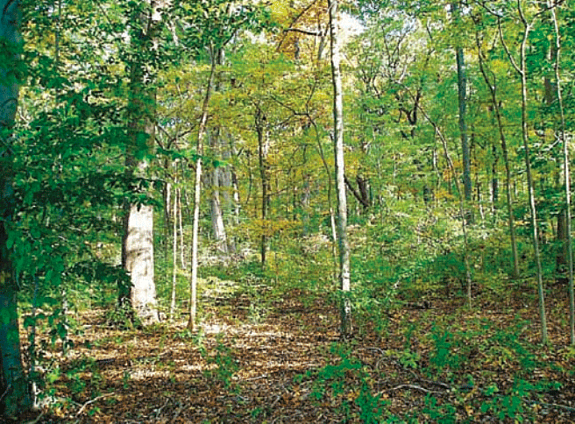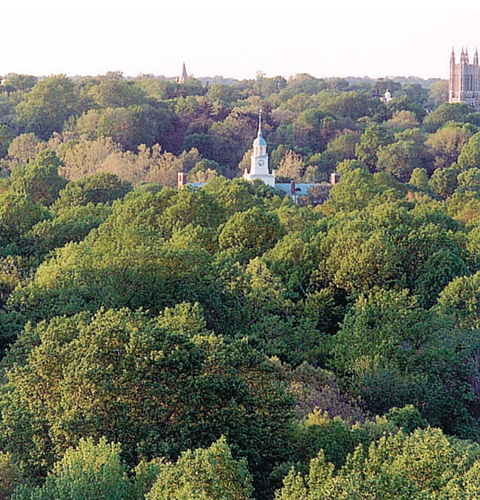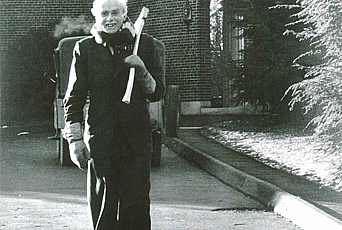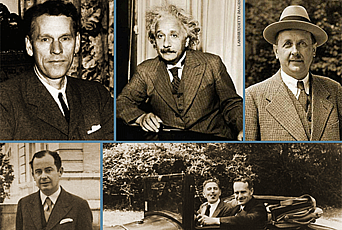The Institute Woods: Protection Against the Noise and the Bustle

More than seventy-five years ago, Founding Director Abraham Flexner sought to create with the Institute for Advanced Study a haven where “scholars and scientists may regard the world and its phenomena as their laboratory, without being carried off by the maelstrom.” To this end, Flexner wrote in a 1931 memorandum to the Board of Trustees that the future site of the Institute “should be large enough to be forever protected against the noise and bustle of urban or commercial life.”
Today, the Institute Woods contain several markers that commemorate the dedication of those who have protected the mission of the Institute and its environment through the decades. In 1950, Institute Director (1947-66) J. Robert Oppenheimer dedicated a Founders’ Walk, which included four miles of trails and paths, the building of a suspension bridge, and a Founders’ Rock with a bronze plaque, inscribed: “Dedicated to Louis Bamberger and his sister Carrie B. F. Fuld whose vision and generosity made this Institute for Advanced Study possible.”
The preservation of the Institute Woods was celebrated by the Institute in 1997 with the dedication of four land markers that tell the history of the land, commemorate its conservation, and acknowledge the more than one thousand contributors involved in the preservation project. Located behind the Thomas Clarke House at Princeton Battlefield State Park, one marker pays special tribute to the late Trustee Frank E. Taplin, Jr. and his wife Peggy Taplin for their “foresight and generosity.” Another acknowledges the Institute’s Board
of Trustees “for vision and support leading to the preservation of these important lands.”
In addition to conserving an historic parcel of land—General George Washington marched his troops through the Institute Woods just prior to engaging in the Battle of Princeton in 1777—the permanent easement protects a fifty-six-mile-long greenway network critical for the feeding and nesting of birds on the Atlantic flyway. It also protects a unique laboratory, with more than forty-five species of trees, for studies of forest succession and what Henry Horn, professor of Ecology and Evolutionary Biology at Princeton University who has conducted extensive research in the Woods for more than thirty years, calls “one of the most renowned natural areas in central New Jersey.”
Oswald Veblen, one of the Institute’s first Faculty members who is credited with persuading Flexner to establish the Institute in Princeton and who was instrumental in the formation of the School of Mathematics, played an active role in the Institute’s acquisition of land between 1936 and 1945 (see story above). In addition to serving on the Buildings and Grounds Committee, Veblen “organized what was called a wood-chopping group,” according to Deane Montgomery, the late School of Mathematics Professor. “They used to go out and clear some of the paths that nobody had cleared at that time.”
Over the years, the Woods have provided a place for contemplation and discussion for generations of Institute scholars from Albert Einstein onwards. Veblen’s tradition of clearing the Woods was carried on by Paul Dirac, a former Member, according to R. H. Dalitz and Sir Rudolf Peierls. Noting Dirac’s fondness for long walks, Dalitz and Peierls noted in Biographical Memoirs of Fellows of the Royal Society, “In Princeton these took him into the woods below the Institute, which were not well kept, with the paths getting overgrown. So Dirac started to work there, and proudly showed visitors the areas he had cleared. A. Pais reports that on one occasion he helped Dirac in his work. The physical work made Pais too hot, and he took off his shirt and singlet and hung them on a nearby branch. Dirac noticed this and, in a gesture of sympathy, took off his tie and hung it near them.”
The late André Weil, former Professor in the School of Mathematics, spent time in the Woods as well. In 1999, Pierre Cartier, a former Member, wrote of Weil, “I had the immense good luck to share long walks with him in the Institute Woods, or sometimes along the frozen Lake Carnegie in winter; we discussed his published articles or ones in progress, or we discussed the plans for Bourbaki.”
In the preface to The Essential John Nash, Harold Kuhn, Professor Emeritus of Mathematical Economics at Princeton University, recalls a conversation he had with Nash, a former Member, in October 1994. “As we sat on the bench, enjoying the mild fall weather and the splendor of the Institute Woods, I told John that he should be up at 6:30 a.m. the following morning to receive a phone call from Carl-Olof Jacobson, secretary general of the Nobel Foundation, who would tell him that he was sharing the Prize in Economic Sciences in Memory of Alfred Nobel.”
School of Mathematics Professor Enrico Bombieri has observed of his late colleague Armand Borel, “He loved nature, and quite often I walked with him in the Institute Woods, talking about the future of mathematics and of our School of Mathematics.” According to Bombieri, Borel “liked the Institute Woods, and he was very relieved when eventually they did not fall to a developer and were preserved as a park. The last time I saw him I mentioned that the same afternoon I was planning to go in the Institute Woods to visit my secret chanterelles patch, maybe I would find a few, would he like to have some too? He had a big smile and just said, ‘Oh, yes!’ I found quite a few chanterelles, and I suspect that they were much better for him than those one can buy in a store, not just because they were fresh, but especially because they came from the Institute Woods.”
The Institute Letter

“I have lived in the proximity of these Woods for over half a century. They are a
friend, a source of inspiration and restoration, and were they to disappear it would be
like the disappearance of an old, beloved, and respected friend.”
—George Kennan, Professor in the School of Historical Studies, 1956-1974; Emeritus, 1974-2005
For more than sixty years, the Institute for Advanced Study has been the steward of 589 acres of woods, wetlands, and farmland that are historically important and environmentally vital to central New Jersey and beyond. The Institute gradually acquired the majority of the land between 1936 and 1945, strengthening the Institute’s endowment and providing a tranquil environment for scholars engaged in theoretical research and intellectual inquiry.
In November, the Regional Planning Partnership presented the Institute with its 2006 Van Zandt Williams Community Involvement Award for the Institute’s role in the permanent conservation of these lands. The conservation was achieved in 1997 through the foresight and dedication of a private-public partnership that involved local and state government, foundations, nonprofit organizations, and more than one thousand individuals. The Institute contributed financially to the conservation and continues today to fund the maintenance of the Woods and farmlands, which are open to the public and utilized year-round by bird watchers, walkers, runners, and cross-country skiers.

